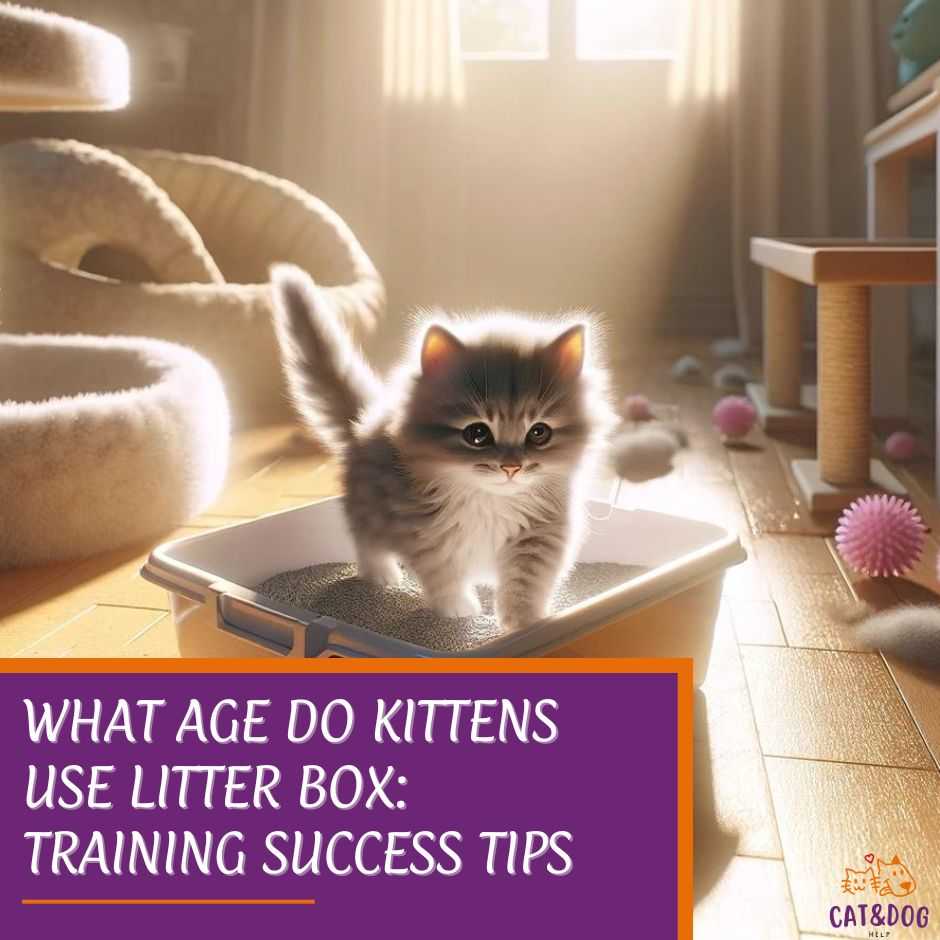Training a kitten to use the litter box is a crucial step in their development and creates a foundation for good hygiene habits throughout their life.
Starting litter box training at the appropriate age makes the process smoother for both you and your kitten. So, what age do kittens use litter box?
Generally, kittens are ready to begin learning how to use a litter box by the time they are 3 to 4 weeks old.
At this age, they have enough control over their bladder and bowel movements to start understanding where they should go.
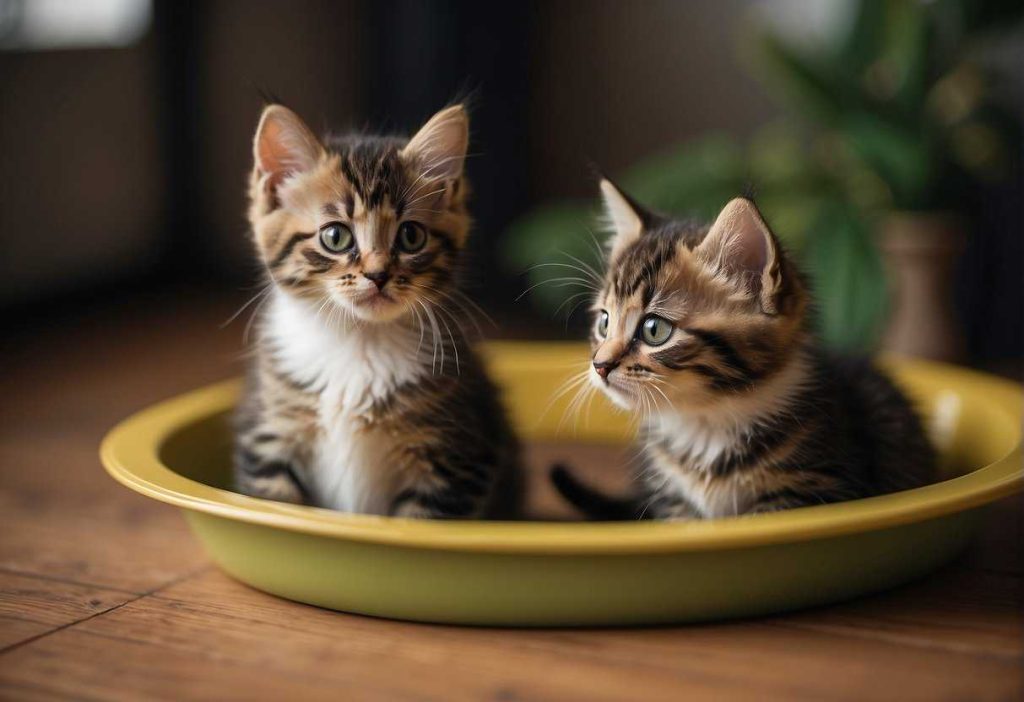
As you prepare for litter box training, you’ll want to ensure that you have the right supplies, including a suitable litter box and kitten-friendly litter.
The process involves showing your kitten the litter box and gently encouraging them to use it. (1)
Reward-based techniques can be particularly effective, giving your kitten positive associations with the litter box. (2)
It’s also useful to be aware of common issues that may arise during training, such as a kitten not using the litter box, so you can address them promptly.
Key Takeaways
- Kittens typically start litter box training around 3-4 weeks of age.
- Proper preparation and a positive approach are key to successful litter box training.
- Being aware of potential training issues allows for timely interventions.
What Age Do Kittens Use Litter Box?
Your little friend can start learning as early as 3 to 4 weeks old. Before this age, mama cat usually takes care of their bathroom needs.
However, when the little felines start munching on solid food, their independence kicks in, and so does their need for a litter box.
Consider these milestones and signs that your kitten is ready:
- Steady on their feet? If you see that playful pounce or steady stroll, they’re physically ready.
- Curiosity high? Kittens who explore more tend to adapt to the box faster.
Here’s a quick checklist of readiness:
- Eating solid food (3)
- Independent walking
- Digging behavior
Here’s how you can gauge whether it’s time to start:
| Milestone | Indicator | Age |
|---|---|---|
| Weaning | Eating solid foods | 3-4 weeks |
| Physical development | Ability to walk steadily | 3-5 weeks |
| Behavioral signs | Showing an interest in digging or covering up waste | 3-5 weeks |
Keep in mind, if they’re showing interest in the corner of a room or scratching at the floor, they’re giving you a hint.
And don’t worry, early training doesn’t mean they’ll master it overnight. It’s a gradual process, with some kittens catching on quickly, while others need a bit more time and patience.
Remember, every kitten is unique!
Preparing for Litter Box Training
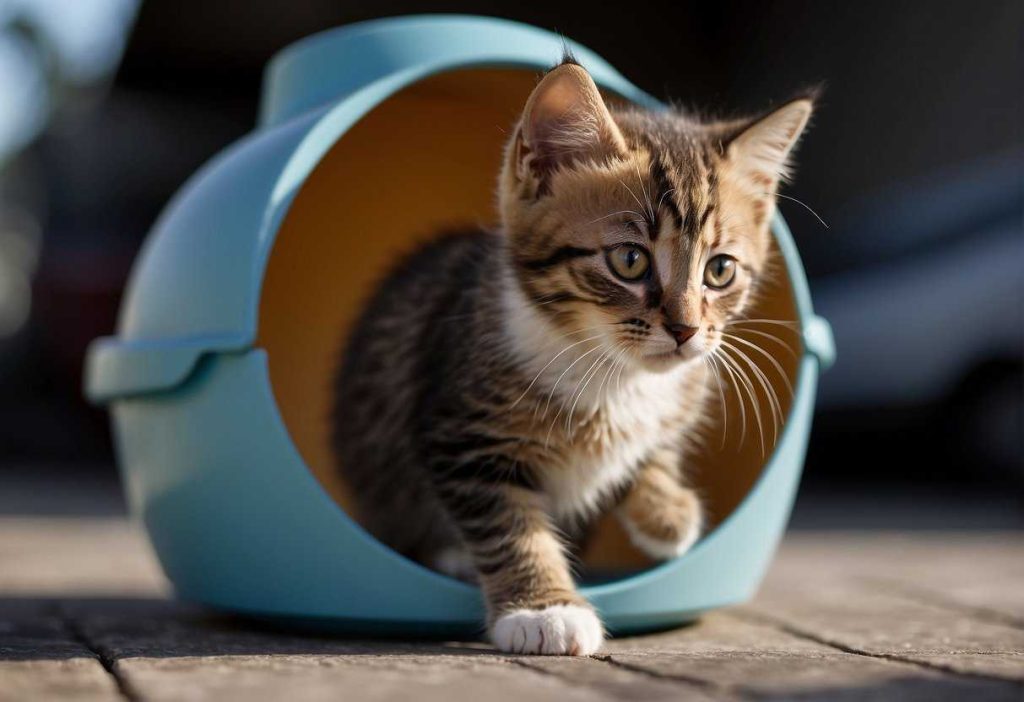
Selecting the Appropriate Litter Box and Litter for Young Kittens
Kittens have tiny paws and can be a tad clumsy, so choosing the right litter box is crucial. What should you look for?
- Types of Litter Boxes and Their Suitability
- Shallow trays: Perfect for small legs to hop in and out with ease.
- Large, enclosed boxes: Maybe later, when they’ve grown a bit.
- Considerations for size, accessibility, and type
- Size: Opt for a smaller box to begin with. Your kitten should be able to get in and out without a high-wire act.
- Accessibility: Low sides are a must-have for the wee ones. No kitten wants the hassle of climbing Everest just to go potty.
- Type: Simple is best. Avoid self-cleaning boxes for now; they can be pretty scary for a mini-mouser. (4)
Choosing the Right Litter Material
Evaluating safety, preferences, and health implications:
- Clumping vs. Non-clumping: Non-clumping litter is gentler for young kittens if they decide to have a taste test. (5)
- Scented vs. Unscented: A kitty’s nose is sensitive, so unscented is the way to go. You’re aiming for comfort, not a perfume counter. (6)
Remember, gentle, absorbent, and easy to dig through – that’s the ideal litter shopping list. Stick with kitten-friendly options, to begin with, and as they grow, you can experiment to find their purr-fect match.
Happy training!
Step-by-Step Guide to Litter Box Training
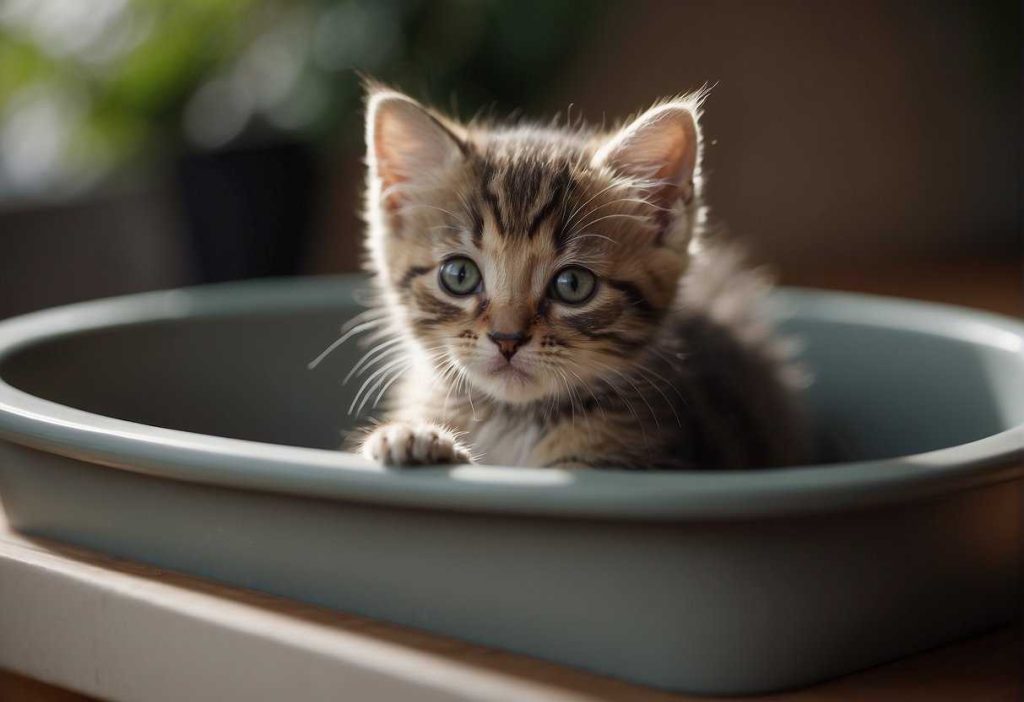
Introducing Your Kitten to the Litter Box
Hey there, new kitten owner! Ready to get your furry friend acquainted with their litter box?
The first time’s a charm! Ensure their initial encounter is stellar:
- Place the litter box in a quiet, accessible spot.
- Use a non-scented, fine-grained litter—most kitties prefer it.
- Gently place your kitten in the box after meals and naps.
Techniques for a Positive First Experience
Believe it or not, cats have instincts for this stuff, but a little guidance doesn’t hurt. Keep it fun with these techniques:
- Lead the Way: Draw their attention to the box by lightly scratching the litter.
- Praise: Whenever they do their business correctly, offer a treat or affection. (7)
Establishing a Consistent Routine
Cats love predictability, and routines set them up for success. Follow these steps, and you’ll be celebrating those litter box victories in no time!
- Meal to Box: Take your kitten to the box after every meal.
- Consistent Spot: Keep the box in the same place so your kitty knows exactly where to go.
- Patience is Key: Never scold for accidents. Encouragement will win this race!
Remember, each kitty is unique, so they might catch on at their own pace. Stick with it, stay positive, and your kitten will be a litter box pro before you know it!
Troubleshooting Common and Early Starter Litter Box Training Issues

Addressing Avoidance and Accidents
- Keep it immaculate! Cats are clean creatures, so a dirty litter box could be the culprit.
- Location matters. Place the litter box in a quiet, accessible spot. A noisy washing machine might just be spooking your kitten.
- Paws-itively hate the scent? Unscented litter is your friend. Many kittens find scented litters off-putting.
Strategies for kittens not using the litter box as expected
- Play detective: Is your kitten skipping the box after meals or play? Time those potty breaks accordingly.
- Multiple boxes: One litter box per cat, plus one extra, can prevent traffic jams.
- Litter variety pack: Offer different types of litter and see which one gets the winner’s paw-pat.
Special Considerations for Early Starters
Some kittens show readiness to litter train as early as 3-4 weeks old. If yours is ahead of the curve:
- Keep it shallow. Young kittens can’t climb Everest! A low-sided box helps.
- Cozy up: A warm, inviting space encourages a positive litter box relationship.
Guidance for kittens showing early readiness or special circumstances
- Health check: If accidents persist, a trip to the vet can rule out any underlying issues.
- Patience pays off: Be encouraging and never scold. Treats and praise go a long way!
Understanding Kitten Development and Litter Box Training
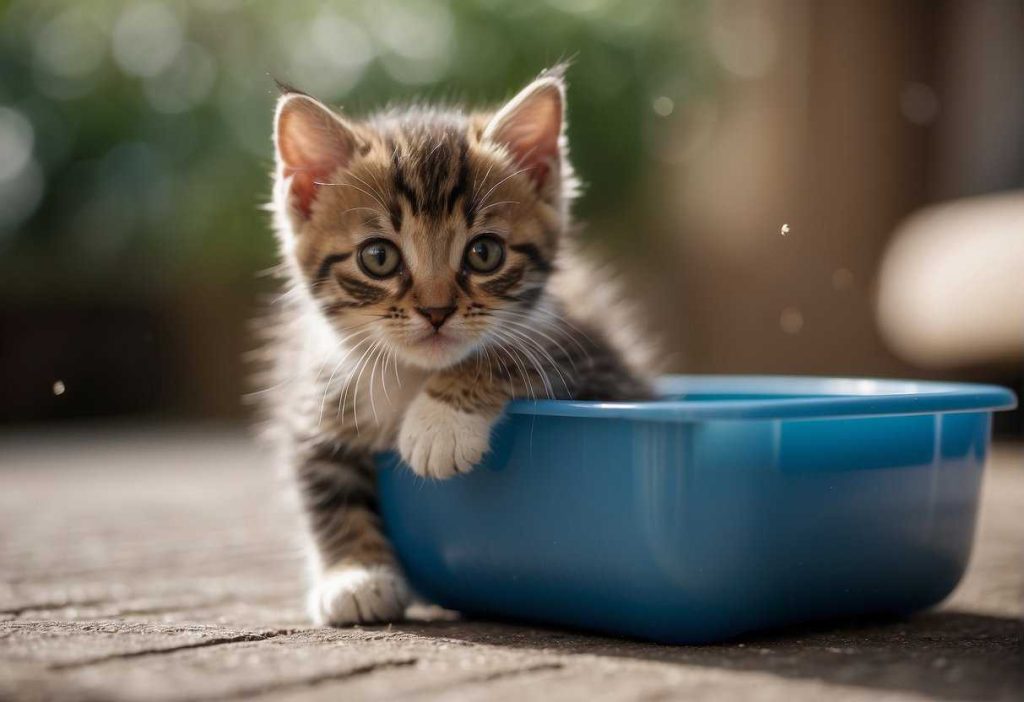
The Importance of Early Training for Lifelong Habits
Encouraging litter box use at a young age helps your furry friend develop good elimination habits for life. Let’s dive in!
- Consistency is key. Show your kitten the box after meals and naps.
- Praise goes a long way. Reward successful use of the litter box with a treat or gentle petting.
Health and Safety Considerations During Early Training
When setting up your kitten’s bathroom, safety first!
- Choose a litter that is non-toxic and dust-free to protect your kitten’s respiratory health.
- The litter box should have low sides so your little one can hop in and out with ease.
Creating a Safe Learning Environment
A cozy spot for the litter box will make training a breeze.
- Keep it in a quiet, accessible location where your kitten can have privacy.
- Cleanliness is crucial. Scoop the box daily to keep it inviting.
Maintaining Good Litter Box Habits and Transitioning as Your Kitten Grows
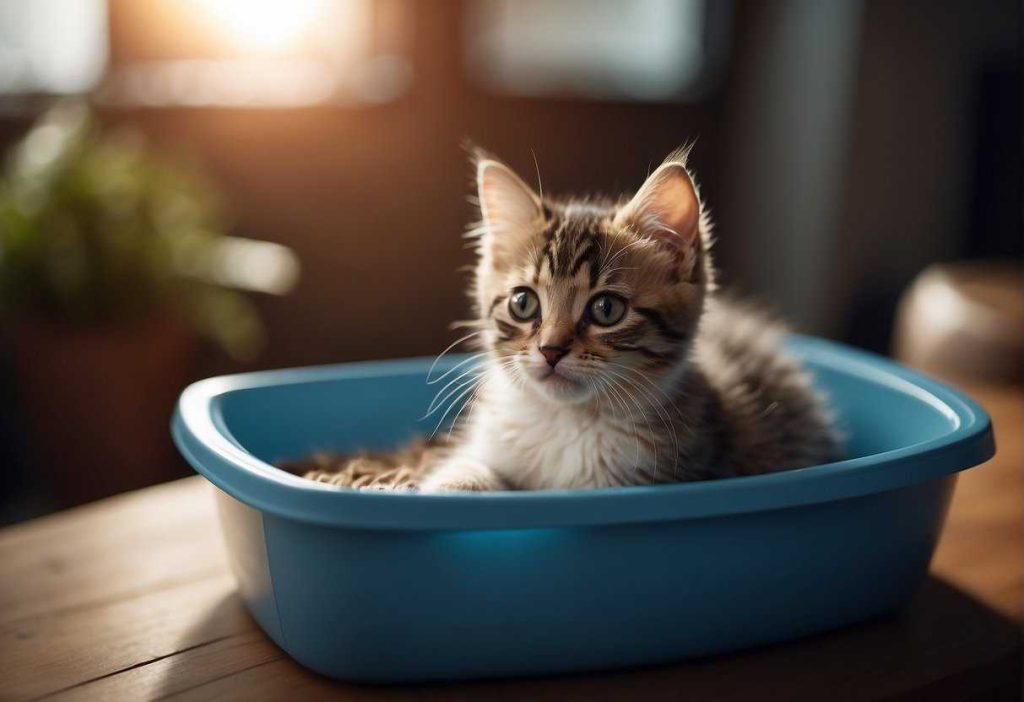
Cleaning and Maintenance for Ongoing Success
Ever wonder why your kitten seems to avoid their litter box sometimes? Keeping it spick-and-span is key! Aim to scoop daily, and mark a full clean on your calendar once a week.
It’s like having a regular spa day for their potty place! Use a mild, unscented soap for cleaning, because perfumes can turn those kitten noses up.
Best Practices for Litter Box Cleanliness and Attractiveness
You’ve got to make that litter box the place to be! Choose a clumping litter for easy clean-up and top it off regularly.
Keep it in a quiet, accessible location, avoiding noisy appliances that could disrupt their peace. It’s kind of like creating a private little restroom lounge just for them.
Adjusting Your Approach as Your Kitten Matures
Do you have a growing kitty on your hands? It’ll soon be time to size up!
Transition to an adult-sized box when they’re around six months old—it gives them more room to dig and turn.
Observe their habits: if they’re hitting the sides or looking cramped, it’s upgrade time!
| Kitten Age | Box Size | Litter Type |
|---|---|---|
| Under 6 months | Small, low-sides | Fine-grained, non-clumping |
| Over 6 months | Large, high-sides | Clumping preferred |
When and How to Transition to Adult-Sized Boxes and Litter Types
As for litter, you might find that kittens under three months old fare better with non-clumping litter, as it’s safer for them.
Once they hit the three-month mark, you’re clear to introduce clumping litter if you notice they’re not ingesting it.
Always ensure there’s enough litter (about 2 inches deep) to satisfy their burying instincts.
Remember, a happy cat is a cat that covers up after itself!
Advanced Strategies and Expert Insights

High-sided litter boxes might just be your savior for those tiny, energetic fur balls.
Kittens, though infinitely curious, can sometimes be a bit clumsy. A high-sided box helps keep the litter (and their business) contained.
For those teeny paws, consider a soft, fine-grained litter.
Young kittens, especially those under 8 weeks, may find coarse litter harsh on their paws. Plus, it can sometimes be a choking hazard if they get too explorative with their mouths.
| Age Bracket | Product Recommendation |
|---|---|
| 3-4 Weeks | Non-clumping litter |
| 4-8 Weeks | Fine-grained clumping litter |
| 8+ Weeks | Your regular clumping litter |
Veterinary professionals, you’ve probably seen it all! Behavioral cues can be your guide.
Kittens that are about 4 weeks old usually start showing interest in digging. That’s when it’s prime time to introduce them to a litter box.
Keep an eye out for those signs, and you’ll know when to take the leap into training!
For you seasoned cat owners, integrating a consistent routine early on is key. Establish a designated “potty area” and gently place your kitten in the litter box after meals and naps.
Remember, patience is a virtue here. Your little buddy is learning a life skill!
Remember to keep the litter box clean. Cats are clean animals and a dirty box might discourage them from using it.
With these insights, you’re well on your way to seamlessly guiding your kitten towards becoming a litter box champ. Happy training!
Quick Recap

Here’s a quick checklist to keep you on track:
- Age Check: By 3-4 weeks, kittens should be introduced to a litter box.
- Consistency Matters: Use a consistent type of litter. Kittens can be picky!
- Location, Location, Location: Keep the litter box in a quiet, accessible spot.
- Size Does Count: Choose a litter box with low sides for easy access for your tiny explorer.
You’ve done a fantastic job so far! Keep encouraging your kitten as she learns. Remember, a clean box and a bit of love go a long way!
Curious about more details or need some extra tips? Look for resources like:
- Books: ‘Understanding Your Kitten’s Behavior’ for in-depth insights.
- Experts: Vet advice never goes astray. They’re like the GPS for your kitten’s journey!
Your dedication is crucial, and you’re doing great! Remember, you’re not alone in this furry adventure. Keep up the fantastic work!
Frequently Asked Questions

At what age can kittens start using a litter box?
Kittens typically begin to use a litter box at around 4 weeks old. Before this, mommy cat assists with bathroom needs.
How do I introduce my kitten to a litter box for the first time?
Place your kitten in the litter box after meals and naps. This encourages them to associate the box with toilet habits.
How can I encourage my 8-week-old kitten to start using the litter box?
Ensure the litter box is easily accessible and place the kitten in the box regularly, particularly after meals or playtime, to encourage use.
What type of litter box and litter is safest for young kittens?
Choose a litter box with low sides for easy entry. Non-clumping, dust-free litter is safest for kittens if ingested during grooming.
Can I train my kitten to use the litter box at any age?
Yes, it’s possible to litter train a kitten at any age, but it’s easier when they’re younger, ideally starting at 4 weeks old.
How many litter boxes do I need for my kitten?
The general rule is one litter box per kitten, plus one extra. So, for one kitten, you should have two litter boxes.
What are the signs that my kitten is ready to use the litter box?
A kitten might be ready if they are scratching or circling on the ground. This behavior often precedes their need to go.
- Advantages of Playing Casino Online - July 6, 2025
- How players can take advantage of the no deposit bonus at the Casino - July 5, 2025

